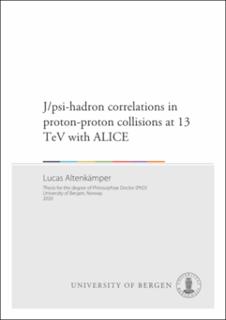J/psi-hadron correlations in proton-proton collisions at 13 TeV with ALICE
Doctoral thesis

Åpne
Permanent lenke
https://hdl.handle.net/11250/2712514Utgivelsesdato
2020-12-17Metadata
Vis full innførselSamlinger
Sammendrag
The production mechanism of the J/ψ provides a testing ground for the under- standing of the strong interaction due to the interplay between perturbative and non-perturbative regimes. It is not yet perfectly understood and some theoretical challenges remain in the description of the underlying processes. New experi- mental observables like the correlation of J/ψ and associated multiplicity might provide new insights and help to constrain the models. In addition, the J/ψ is an important observable for deconfinement in heavy ion collisions and measurements in proton-proton collisions yield relevant baselines for such studies.
In the analysis presented in this thesis, the angular correlations between uniden- tified, charged hadrons and inclusive, non-prompt and prompt J/ψ are measured in proton-proton collisions at center-of-mass energies of 13 TeV. The data has been recorded by the ALICE experiment at the CERN LHC in the period from 2016 to 2018 and different triggers are exploited to maximize the available statistics and phase space coverage. The J/ψ mesons are reconstructed in the electron-positron decay channel at mid-rapidity and measured down to vanishing transverse momen- tum. The correlation functions are determined in different kinematical regimes and the correlated yields are evaluated in addition.
The results shown in this thesis represent the first measurement of the non- prompt and prompt J/ψ correlation functions at mid-rapidity by ALICE. While statistically limited, the results provide a good starting point for the comparison to model calculations and hint at the importance of hard interactions in the J/ψ production mechanism. Indications of differences between minimum bias and high multiplicity events are observed which should motivate future analyses based on higher statistics data samples. The results are compared to PYTHIA simulations which qualitatively agree with the data and seem to reproduce most of the features observed.
